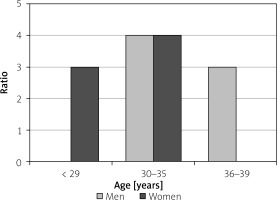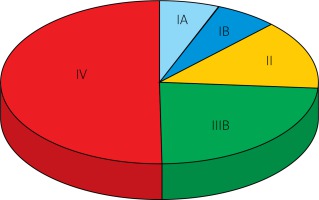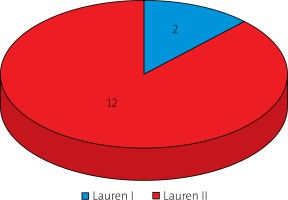Introduction
Stomach cancer remains one of the most common causes of death due to cancer in the world. It is believed that it mainly affects patients in the 5th–7th decade of life and more often concerns men. This cancer is to be found mostly in the population of Japan, Korea, South America, and Eastern Europe. Its incidence is much lower in the population of the US [1–8].
In Poland, the incidence of gastric cancer has been at the same level for years and ranges between 5200 and 5500 new cases annually, although its decline is observed. At the same time, among Polish doctors, there is still a misconception that young people cannot suffer from cancers of the gastrointestinal tract, especially stomach cancer, which often has tragic consequences. More and more often we observe young people with advanced cancerous lesions in the intestines, stomach, or pancreas, who were diagnosed with symptoms that may suggest gastrointestinal neoplasms, but due to their young age, these were wrongly excluded at the beginning.
Aim
The aim of the study was to analyse the prevalence, severity, and survival of patients aged under 40 years treated surgically in the Second Department of General and Gastroenterological Surgery of the Medical University of Bialystok. The type and frequency of the onset of symptoms in the examined group were also evaluated.
Material and methods
The analysis involved 350 cases of patients treated in the Second Department of General and Gastroenterological Surgery of the Medical University of Bialystok. The study group consisted of 14 cases of patients aged 18 to 39 years (the average age was 33 years). This accounted for approximately 4% of all patients treated in the Department for gastric cancer. The group included seven men and seven women. All female patients were in the age range from 18 to 35 years, while in the case of men the age ranged from 30 to 39 years.
Results
Based on the analysis, it was found that in women stomach cancer occurred much earlier, i.e. the youngest patient was 18 years old and the oldest was 35 years old. In the group of men, the youngest patient was 35 years old and the oldest was 39 (Figure 1). As far as the stage of progression according to current TNM classification is concerned, the most advanced IV stage was most frequently observed, and it involved seven patients. Grades II and III according to TNM were found in the same percentage of patients, i.e. there were three patients in both groups (Figure 2). The first grade according to the TNM classification was found in only one patient; this patient is still under clinical observation (at present, the survival after the surgery is 6 years). More advanced lesions were found in women (in 5 female patients at the time of the study there was stage IV of advancement vs. two men, and one stage III woman vs. two men).
In 2 cases, a double-sided Krukenberg tumour was found during the operation.
As far as histopathological diagnosis is concerned, in 12 cases there was a Lauren-type stomach cancer (6 women vs. 6 men), and two cases of intestinal type (one woman vs. one man) (Figure 3).
In 10 cases, complete gastrectomy with regional lymphadenectomy (at least D2) was performed. In 4 patients the gastrointestinal tract was reconstructed by the DTR or double tract reconstruction method, while in the remaining 6 cases the Roux-en-Y technique was used. In 4 cases, due to the severity of the disease, we were only able to collect tissue samples from the tumour for histopathological examination and perform a gastric by-pass anastomosis due to stenosis.
In the examined group non-specific abdominal pain was observed in all patients, with aches in the area of the cardiac cavity. These complaints occurred in all patients and lasted from 3 to 18 months before hospitalisation in the Department. There were 10 patients with the problem of bumps and a rapid feeling of postprandial fullness. Weight loss was found in 12 patients and ranged from 4–10 kg in 3 to 12 months. Persistent vomiting was observed in 5 and melaena occurred in 3 patients.
At present, four patients remain under clinical surveillance (1 woman and 3 men). Other patients died within 1 month to 3 years after the surgery. On average, this time was 1.25 years.
Discussion
Stomach cancer occurs most often in the age group from 50 to 70 years and more often concerns men [1–3]. The percentage of gastric cancer in patients under 40 years old is estimated at a level of 2% to 8%. In our study, it was 4%. This is within the limits given by the available literature [1–4, 9, 10]. The reports also raise the fact that in young people cancer is diagnosed in more advanced stages, and it is much less differentiated compared to the group of older patients [8, 9]. The above observations were also confirmed in our study (we were more likely to have diffuse tumours according to Lauren, and grades IV and III according to TNM were found in 70% of respondents). At the same time, the general statement that young patients have much shorter survival time compared to the elderly group was confirmed. The average survival in available literature was about 10.3 months [11, 12]. In our study, it was longer and was about 15 months, but in comparison with Japan and South Korea we definitely lag behind (about 60% of the surveyed young people with stomach cancer survive there for 5 or more years) [10, 11]. In the majority of reports on groups of young patients, gastric cancer occurred more often in women than men (1.14 : 1) [3, 13, 14]. In our study, however, it was 1 : 1. The observations are a definite reversal compared to the prevalence of cancer in relation to sex in the elderly (males vs. females – 1 : 0.45) [3, 13, 14].
The incidence of symptoms in our study does not differ from those in other reports. It is noteworthy that the time of occurrence of ailments is much longer and the advancement of changes at the time of diagnosis is worse than in reports from the Far East [15–17].
Conclusions
Stomach cancer in young people is detected late because there is a false belief that this type of cancer affects only older people. The neoplastic lesions are of advanced local stage at the time of diagnosis. This has a negative effect on long-term treatment results. The average survival time in most cases does not exceed 6 months.













